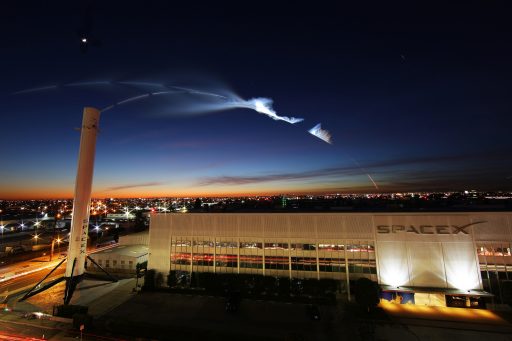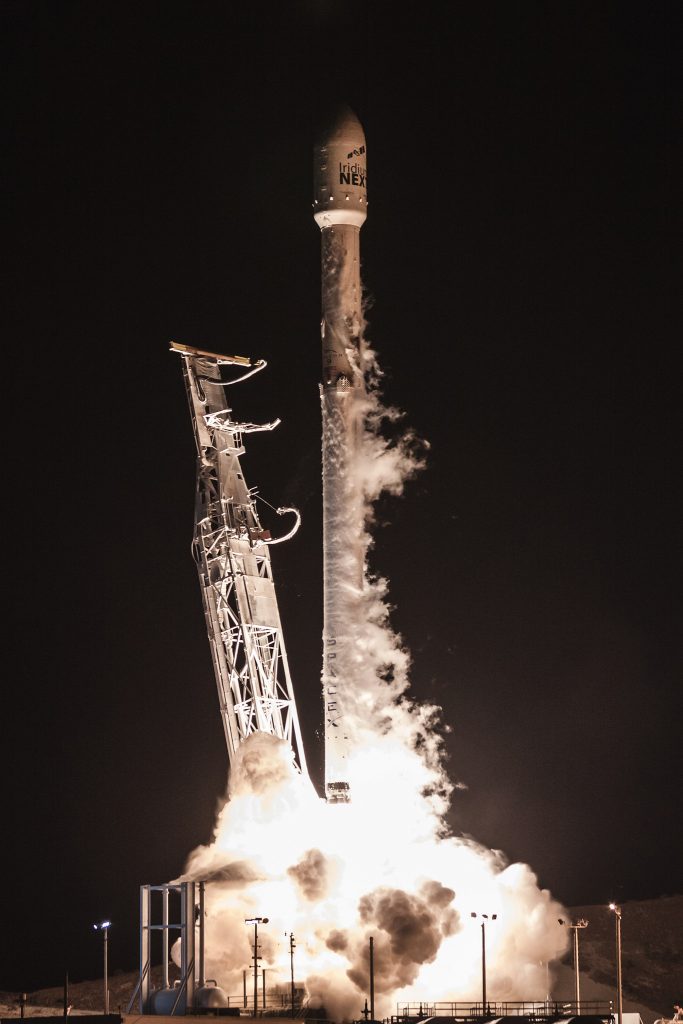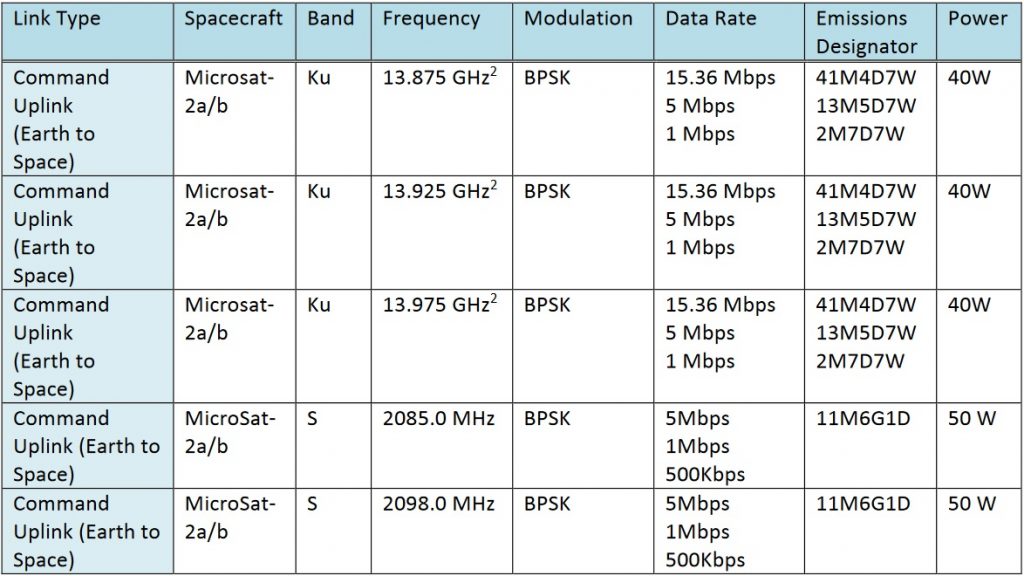MicroSat-2a & 2B

MicroSat-2a and 2b are two 400-Kilogram prototype satellites developed and built by SpaceX for a proof-of-concept mission of the company’s planned Starlink constellation to provide global broadband Internet access. These MicroSatellites, launching in 2018, replace the MicroSat 1a and 1b missions which were demoted to ground-based tests in favor of two satellites closer to the operational design.
SpaceX has been tight-lipped about the specifics of the Starlink System and no photos and/or technical details on the demonstration satellites or operational constellation have been released leading up to the prototype launch. The only firm pieces of information stem from regulatory filings made by SpaceX with the Federal Communications Commission that allocates satellite frequency bands. As of 2015, these flings indicated the California-based company planned to launch up to 4,000 non-Geostationary Satellites to create the Starlink constellation; in 2017, the number of satellites to be launched by the mid-2020 was increased to 11,943 in two constellation segments – one comprising 4,425 satellites using Ku/Ka/V-Band communications and one with 7,518 members only operating in the seldom-used V-Band.
SpaceX announced its intent of developing a low-orbiting constellation for Internet access in January 2015 with a projected capability of carrying up to 50% of all backhaul communications traffic and 10% of local traffic in high-density cities. Company CEO and Chief Designer Elon Musk cited the motivation behind the project in a significant unmet demand for low-cost global broadband capabilities. Development of Starlink was formally started with the opening of the SpaceX satellite development facility in Redmond, Washington in January 2015, initially starting out with a few dozen employees for the development and prototype phase of the project.

By late 2016, SpaceX’s Redmond operation had taken on 2,800 square meters of leased space and a 3,800m² facility was added by early 2017. Initially, the plan had called for a demonstration launch in 2016 and deployment of the initial operational constellation by 2020; however, major design changes had made the two original prototype satellites obsolete and the launch of two revised satellites had been re-aligned for 2018.
SpaceX’s satellite venture expanded to Irvine, California in July 2016 when the company acquired 740m² of creative space to facilitate the development of signal processing electronics and Radio Frequency/Application Integrated Circuits for the satellite program and customer ground transceivers.
As of October 2016, SpaceX noted the program was still in the design phase as the company worked to solve the issue of developing ground equipment of sufficiently low cost for broad application by end users. The goal expressed by SpaceX was a cost of $200 for end-user phased-array transceiver equipment that would enable access to the constellation.
Regulatory FCC filings in March and September 2017 provided the first comprehensive details on the architecture of the Starlink Constellation – a name revealed in August through legal documents seeking to trademark the name for the broadband satellite network. According to these FCC filings, SpaceX plans to field a constellation of 4,425 Ku/Ka/V-Band satellites in a Low Earth Orbit of 1,100 to 1,300 Kilometers and 7,518 V-Band satellites in a Very Low Earth Orbit 335 to 346 Kilometers in altitude.
The V-Band spectrum stretches from 40 to 75 GHz (directly following the K-bands from 12-40 GHz) and has not been readily utilized for satellite communications. Only very few Geostationary Satellites have used Q-Band (a sub-band of 33-50GHz) which is widely considered the future of high-throughput communications, but still in its infancy in terms of operational use. The Extremely High Frequency (EHF) Q-Band has been studied extensively for high-throughput satellite programs in which the feeder links (satellite to ground gateway & vice versa) would use Q-Band to free up additional user bandwidth in Ka-Band.
However, communications at these higher frequencies are susceptible to atmospheric fluctuations like areas of bad weather as rain can attenuate the millimeter-wavelength signals – requiring mitigation either through using multiple ground hubs or adaptive coding and modulation (ACM) techniques.
In its 2017 FCC requests, SpaceX proposed to use the 37.5-42.0 GHz frequency band for Space-to-Earth communications and a band of 47.2-50.2 and 50.4-52.4 for Earth-to-Space links. The requests also detailed plans of launching prototype satellites in 2018 and begin launching operational satellites in 2019 with full build-out of the constellation foreseen until 2024 at which point there are expected to be 4,425 satellites in orbit around Earth, operating in 83 orbital planes 1,200 Kilometers in altitude.
Additional documentation submitted by SpaceX to the FCC clarified the company’s space debris mitigation plan that calls for an “orderly de-orbit of satellites nearing the end of their useful lives (roughly five to seven years) at a rate far faster than is required under international standards.” The method for deorbitation would be to lower satellites into a disposal orbit with plenty of atmospheric interaction to bring them to a natural re-entry around one year after completing their mission.

MicroSat-2a and 2b are riding as secondary payloads on the PAZ mission and will be delivered to the same 514 x 514-Kilometers Sun Synchronous Orbit as the primary payload from where they will use their onboard propulsion systems to boost themselves to their desired mission altitude of 1,125 Kilometers. Both satellites are identical in design and are expected to be actively used for testing operations for six to twelve months after which they will be placed in disposal orbits.
The MicroSat-2a and 2b satellites are around 1.1 by 0.7 by 0.7 meters in size when launching and each has two 2 x 8-meter deployable solar arrays. Each satellite carries a phased array broadband antenna communications platform to carry out a demonstration of proposed earth-to-space, space-to-space, and space-to-earth communication pathways as needed for the operational NGSO constellation. “SpaceX intends to test the Microsat-2a and -2b communication paths utilizing five broadband array test ground stations located in the western United States, as well as three transportable ground stations that will be deployed near the fixed ground station locations, all within the contiguous United States (“CONUS”). With the orbit profile provided, broadband array tests (Ku-band) will be conducted on average once every 0.9 days for less than 15 minutes.”
The MicroSat-2a and 2b testing program focuses on the RF characteristics of the satellite broadband platforms, the data throughput capability of the different links and pointing of the broadband array as well as seamless handoffs between ground stations. Both satellites carry low-resolution imaging systems whose data will be carried through the Ku/Ka-Band system plus an X-Band telemetry/video transmitter.
According to documentation filed with the FCC, MicroSat-2a and 2b will use the following communications links:

